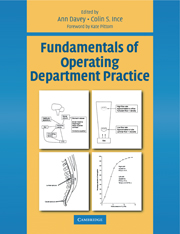Book contents
- Frontmatter
- Contents
- Contributors
- Preface
- Foreword
- Acknowledgements
- Introduction
- Chapter 1 The operating department practitioner, the patient and the law
- Chapter 2 Aspects of health and safety in the operating department
- Chapter 3 The caring practitioner
- Chapter 4 Strategies for infection control in the operating department
- Chapter 5 Sterilization, decontamination and the surgical field
- Chapter 6 The fundamentals of cardiovascular physiology
- Chapter 7 Fundamentals of respiratory physiology
- Chapter 8 Scientific principles in relation to the anaesthetic machine
- Chapter 9 Fundamentals of artificial ventilation of the lung
- Chapter 10 Scientific principles in relation to monitoring equipment
- Chapter 11 Scientific principles in relation to endoscopic, laser and radiological equipment
- Chapter 12 Pharmacological principles of drug administration
- Chapter 13 The pharmacology of drugs used in general anaesthesia
- Chapter 14 The local anaesthetic drugs - does the ideal agent exist?
- Chapter 15 The safe positioning of patients for surgery
- Chapter 16 Principles involved in the management and use of equipment
- Chapter 17 Understanding suture materials
- Chapter 18 Fundamentals ofpaediatric surgery and anaesthesia
- Chapter 19 Fundamentals of hyperthermia and hypothermia
- Chapter 20 Fundamentals of fluid and electrolyte balance during surgery
- Chapter 21 The physiology of blood and its administration
- Chapter 22 Fundamentals of pain relief
- Chapter 23 Fundamentals of dressings and drains in relation to wound healing
- Chapter 24 The recovery of patients from anaesthesia and surgery
- Chapter 25 Fundamentals of emergency and obstetric anaesthesia
- Chapter 26 Identification and management of anaesthetic emergencies
- Chapter 27 The fundamentals of emergency resuscitation
- Appendixes
- Index
Chapter 2 - Aspects of health and safety in the operating department
Published online by Cambridge University Press: 05 October 2015
- Frontmatter
- Contents
- Contributors
- Preface
- Foreword
- Acknowledgements
- Introduction
- Chapter 1 The operating department practitioner, the patient and the law
- Chapter 2 Aspects of health and safety in the operating department
- Chapter 3 The caring practitioner
- Chapter 4 Strategies for infection control in the operating department
- Chapter 5 Sterilization, decontamination and the surgical field
- Chapter 6 The fundamentals of cardiovascular physiology
- Chapter 7 Fundamentals of respiratory physiology
- Chapter 8 Scientific principles in relation to the anaesthetic machine
- Chapter 9 Fundamentals of artificial ventilation of the lung
- Chapter 10 Scientific principles in relation to monitoring equipment
- Chapter 11 Scientific principles in relation to endoscopic, laser and radiological equipment
- Chapter 12 Pharmacological principles of drug administration
- Chapter 13 The pharmacology of drugs used in general anaesthesia
- Chapter 14 The local anaesthetic drugs - does the ideal agent exist?
- Chapter 15 The safe positioning of patients for surgery
- Chapter 16 Principles involved in the management and use of equipment
- Chapter 17 Understanding suture materials
- Chapter 18 Fundamentals ofpaediatric surgery and anaesthesia
- Chapter 19 Fundamentals of hyperthermia and hypothermia
- Chapter 20 Fundamentals of fluid and electrolyte balance during surgery
- Chapter 21 The physiology of blood and its administration
- Chapter 22 Fundamentals of pain relief
- Chapter 23 Fundamentals of dressings and drains in relation to wound healing
- Chapter 24 The recovery of patients from anaesthesia and surgery
- Chapter 25 Fundamentals of emergency and obstetric anaesthesia
- Chapter 26 Identification and management of anaesthetic emergencies
- Chapter 27 The fundamentals of emergency resuscitation
- Appendixes
- Index
Summary
Amongst the wide range of procedures undertaken during an average working day in the operating theatre environment, many either have the potential for causing harm or involve the use of hazardous substances. The necessity for safe practice is obvious but as perception of the problem among theatre workers increases, the real potential degree of this risk becomes apparent.
CROWN IMMUNITY
Crown immunity may have resulted in a lack of awareness and action as, prior to April 1991, hospitals within the NHS had a somewhat optional approach to liability until the implementation of Health and Safety law. Because of this, staff in the clinical areas generally remained unaware of this important and increasingly essential piece of protective legislation. However, their opposite numbers within the industrial sector implemented and developed the intention of the law, which was to create a safe place of work and safe working practices. It is possible, therefore, that some hospital staff were exposed to potential dangers from which workers in the industrial sector were legally protected.
THE HEALTH AND SAFETY AT WORK ACT
All present Health and Safety regulations, codes of practice and guidance arise from the 1974 Health and Safety at Work Act (HASAWA). This Act represented a new concept in legislation intended to protect workers and others from risks at work as well as from dangers that might arise due to work situations. Prior to this act, for many years there had been a group of statutes covering certain industries and occupations, which were partly concerned with safety but were increasingly felt to be inadequate.
The 1972 Robens Report was commissioned to examine the effectiveness of existing legislation and make recommendations for change - hence the introduction of the HASAWA. This brought together the existing statutes while allowing for implementation of new ones, thus creating a uniformity of employee protection across the working population. As a result, approximately eight million more workers gained occupational protection under the law. The 1974 legislation is an “enabling” act, allowing for the relevant government minister, i.e. Minister/Secretary of State for Employment, to add new pieces of safety legislation as and when required, without going through the lengthy process of parliamentary statute law.
- Type
- Chapter
- Information
- Fundamentals of Operating Department Practice , pp. 21 - 26Publisher: Cambridge University PressPrint publication year: 1999



